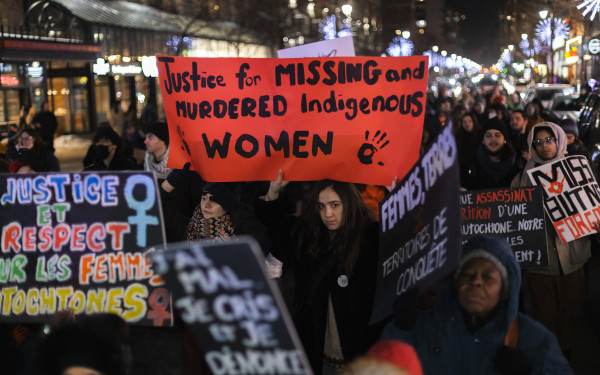Invisible Minorities?
Underrepresentation of Women, People of Colour an Unacceptable Phenomenon
When Myriam Tardif, Rushdia Mehreen and Beatriz Munoz recently resigned from the Association pour une solidarité syndicale étudiante, they made sure everyone knew it was because of their minority statuses.
Tardif, Mehreen and Munoz made up the student association’s three-member Comité aux luttes sociales, a committee that deals with social issues. They posted an open letter of resignation online on Feb. 1, describing their experiences working in an environment where minorities seemed less welcome.
“More and more, we noticed a kind of contempt towards students of different races, allophones or anglophones, as though their capacity to understand the stakes and debates were doubted […] during coordination council meetings,” the letter reads in French.
While ASSÉ might be considered one of the most mobile and radical student organizations in Quebec, these resignations indicate a need to re-evaluate whether all students are being properly represented.
“Some of us got the impression we were considered less intelligent, because of our language or the way we spoke,” the letter continues. “Maybe these people don’t have the same experiences as others in the French militant ‘milieu,’ but their accomplishments and experiences in terms of social involvement are also valuable.”
The Comité aux luttes sociales is not alone. Just last week ASSÉ’s women’s committee, which promotes feminism within the association, revised an open letter on its Facebook page concerning issues of domination and elitism within ASSÉ.
The letter specifically addresses the ways some delegates act during assemblies, such as using derogatory language, seeming indifferent or impudent and even pounding their fists on tables.
“The ‘profile type’ of a delegate who speaks in front at the assembly without shyness or apprehension is the white male university student from Montreal who studies at UQAM,” the letter reads, pointing out the need for those who fall under that profile to realize their privileges and the significance of the situation.
Big Business and Politics
Meanwhile, things don’t seem to improve much after graduation. The reality of Montreal’s business community echoes ASSÉ’s underrepresentation woes.
A study led by researchers from McGill University’s Desautels Faculty of Management and Ryerson University’s Diversity Institute has found that women and visible minorities are strikingly underrepresented in senior leadership roles in Montreal.
Women account for 31.2 per cent of senior leaders, while visible minorities fill 5.9 per cent of these positions despite making up 22.5 per cent of Montreal’s population.
Still, organizations that promote diversity and make it a reality in the workplace outperform those that don’t, writes Suzanne Gagnon, co-author of the study Women and Visible Minorities in Senior Leadership Positions: A Profile of Greater Montreal.
“Previous research has shown a clear link between diversity in leadership and a number of social and economic benefits,” writes Gagnon.
“Diverse leadership improves organizational financial performance and stimulates innovation, among other well-documented benefits.”
Women have come a long way since 1957, when only two members of Parliament were female. Still, even with 76 seats in the House of Commons (27 of which are in Quebec ridings), women are dangerously underrepresented in Parliament, making up only 25 per cent of our federally elected officials.
First Peoples fare only slightly better when it comes to representation in the federal government. Seven MPs (with 2.3 per cent of seats) are of First Nations, Inuit or Métis origins, although First Peoples make up 3.8 per cent of the population.
In 2011, visible minorities only won half of their fair share of seats in the House of Commons—29 seats, or 9.4 per cent—while making up 16.2 per cent of the population.
Closer to home, women make up only 37.8 per cent of Montreal’s elected officials and 29.8 per cent of its public sector leadership; less than a third of Concordia’s Board of Governors is female.
Contrast this to the rise of women leaders at the provincial level. With the election of Kathleen Wynne, Ontario’s first female premier and Canada’s first openly gay provincial leader, five provinces and one territory are now led by women.
While female provincial leaders are certainly changing the face of politics in Canada, women still make up at most a third of provincial legislatures. Quebec’s National Assembly has a record 41 female MNAs out of 125.
That isn’t to say women are doomed in Quebec politics. In 2007, former Quebec premier Jean Charest was praised for appointing the first gender-equal Cabinet. The previous year, Charest successfully legislated gender parity on the boards of 24 of Quebec’s Crown corporations.
Quebec’s private sector and the rest of Canada’s business world are lagging behind, however. Women make up only 14 per cent of Board of Directors members at Canada’s largest companies.
Taking Action
Affirmative action—the legal act of positive discrimination—is meant to establish balanced demographic representations that do not naturally exist because of social and cultural bias.
Theoretically, if the number of hired racial minority or female candidates is representative of society, no one loses. The business flourishes, women and visible minorities are adequately represented and everyone stops blaming white men for the problems of the world.
One misconception is that women don’t occupy these roles because none of them are qualified. But the reality is that there isn’t a shortage of qualified potential candidates. Women post-secondary grads outnumber men in most programs, including those related to business, administration, social sciences and law.
Affirmative action works both ways, however. Canada’s largest school board, the Toronto District School Board, sent out a memo last week stating preferences for racial minorities and male candidates to better represent increasingly racialized student populations.
Elementary and high school teachers are typically white and female, and students who are neither are lacking role models in a place where they spend most of their childhood and adolescence.
Of course, quota laws that enforce absolute gender parity are excessive; to assume there will always be an equal participation rate between the sexes in federal, provincial and municipal politics and on every corporate board is wishful thinking.
It’s normal that the number of women in politics and in corporations will fluctuate. Hopefully in the future, though, the number of women will occasionally surpass the number of men.
Affirmative action isn’t as much about reserving places for women and minorities so much as letting them know there is a place for them in white male-dominated sectors.
While it’s a stretch to demand that student organizations like ASSÉ enforce some form of affirmative action policy, these organizations should be conscious of how well they are really representing their student members if racialized and female committee members are calling out their leaders’ behaviour.
However, in politics and positions of authority, such as corporations and governing boards, affirmative action should be enforced until the playing field is levelled and equal representation becomes a reality.
Gender parity and affirmative action do seem like contradictory solutions for discrimination in the workplace. If men and women and people from ethnically diverse backgrounds are equal, and if they are not be judged by their gender or ethnicity, then proportional representation will occur naturally.
But the simple truth is that equality doesn’t just happen by itself. Sometimes, it needs a push to catch up.

(WEB)_900_842_90.jpg)

_600_375_s_c1.png)


_(1)_600_375_s_c1.png)